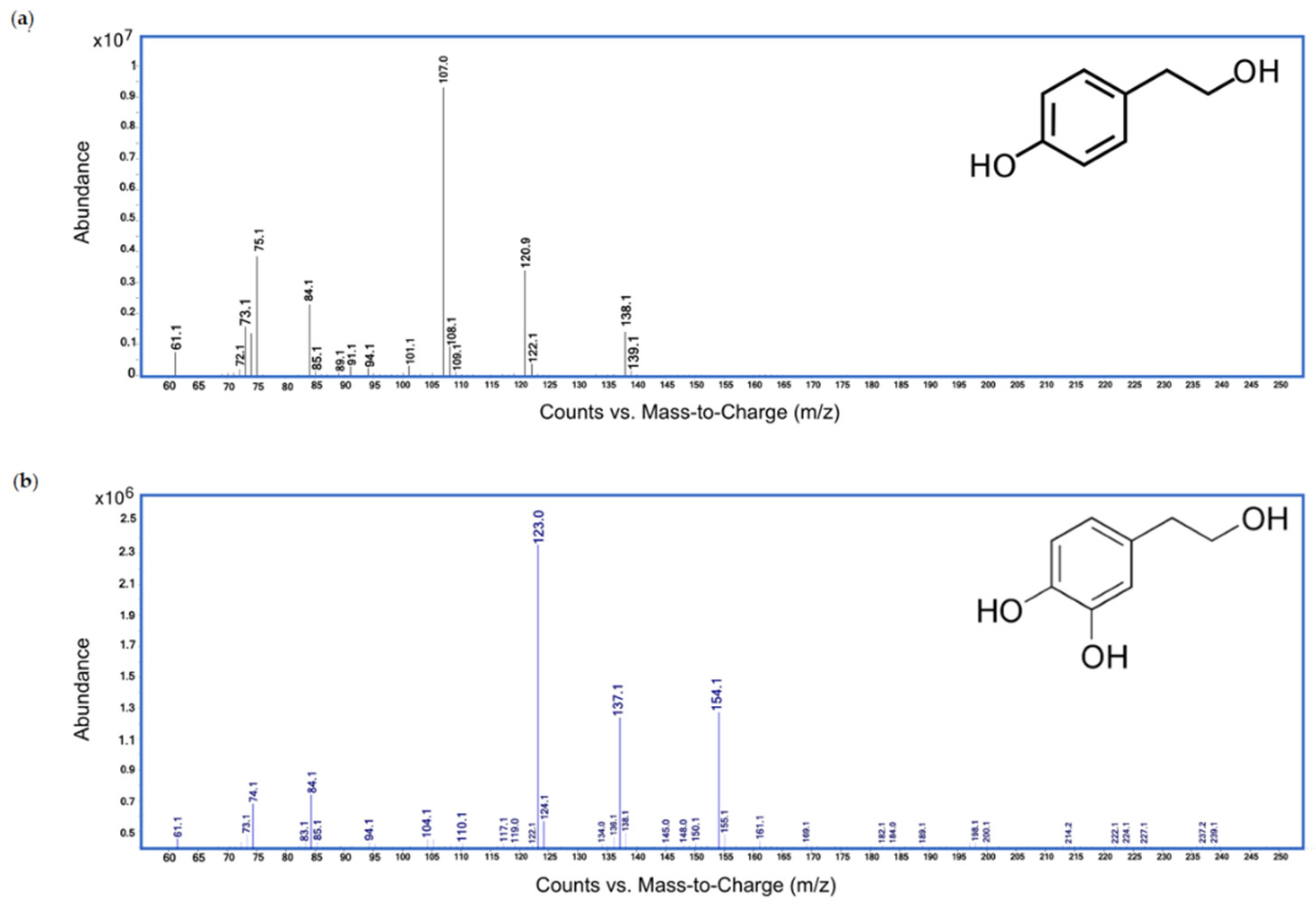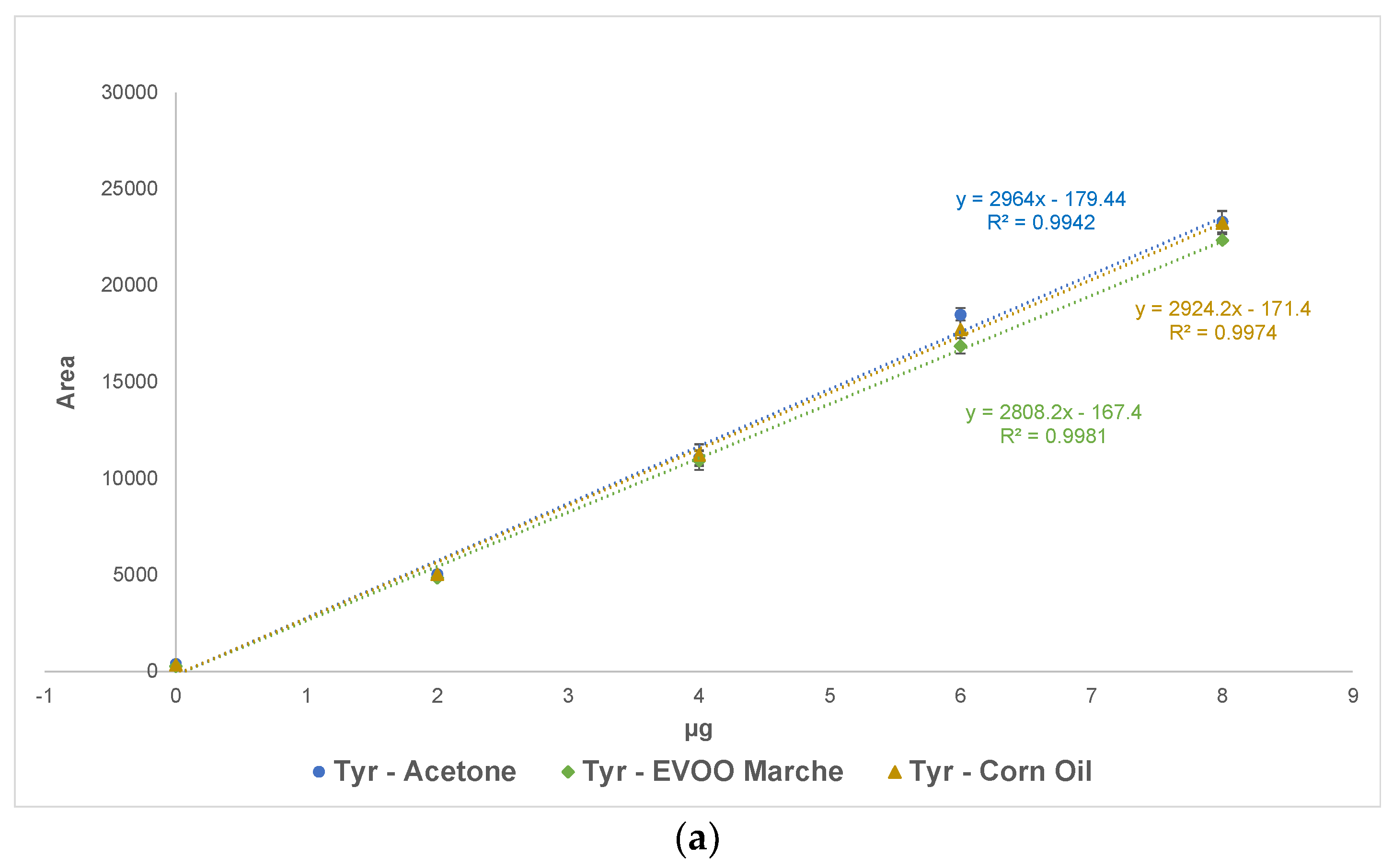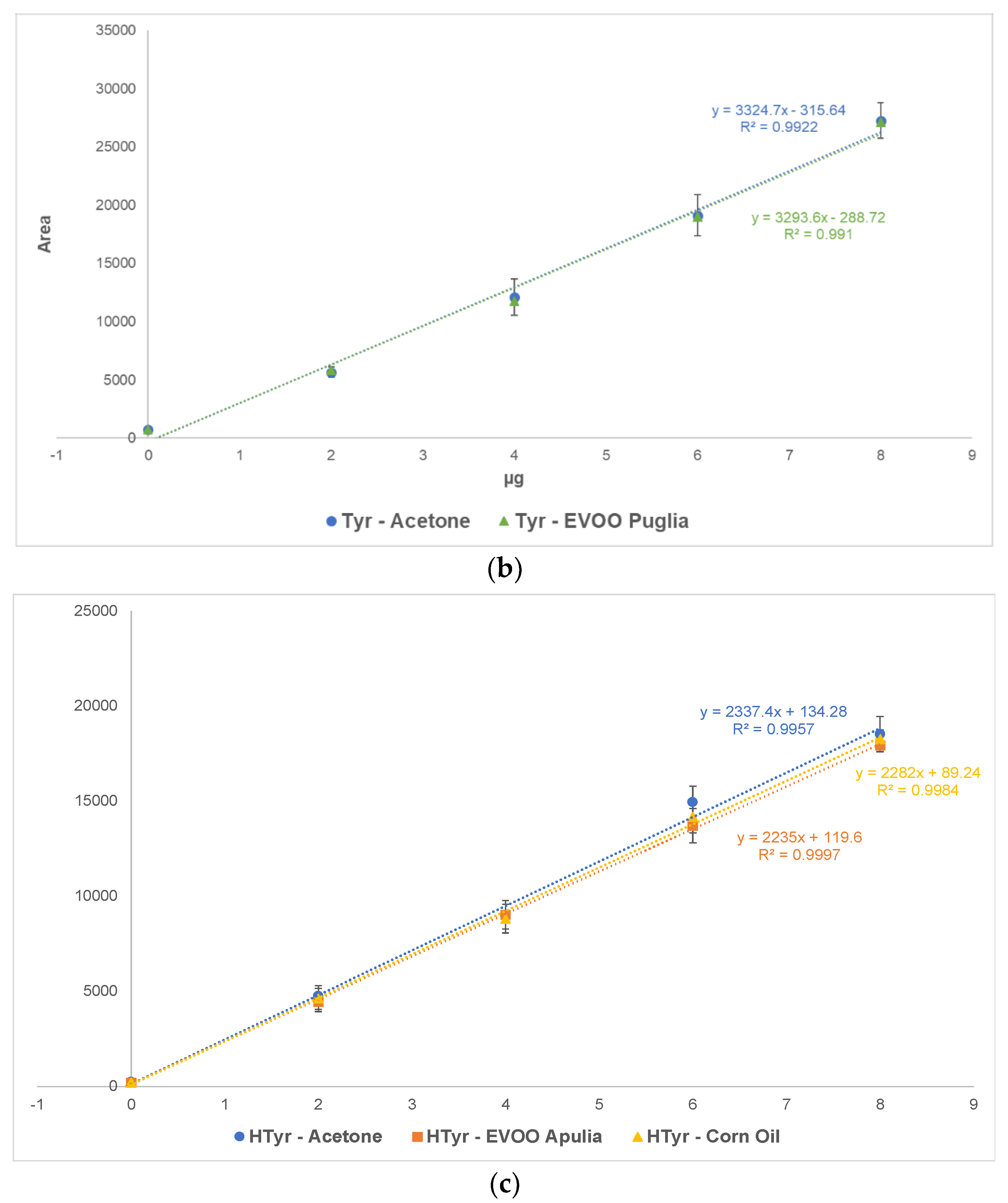Tyrosol and Hydroxytyrosol Determination in Extra Virgin Olive Oil with Direct Liquid Electron Ionization-Tandem Mass Spectrometry
Abstract
:1. Introduction
2. Materials and Methods
2.1. Chemicals
2.2. Standard Solutions and Extra Virgin Olive Oil Samples
2.3. LC–LEI–MS/MS Apparatus and Working Conditions
3. Results and Discussion
3.1. Qualitative Results
3.2. Method Validation
3.2.1. Linear Range
3.2.2. Limits of Detection and Quantification
3.2.3. Evaluation of Matrix Effects
3.2.4. Precision
3.3. Real Samples Analyses
4. Conclusions
Author Contributions
Funding
Acknowledgments
Conflicts of Interest
References
- Veneziani, G.; Sordini, B.; Taticchi, A.; Esposto, S.; Selvaggini, R.; Urbani, S.; Di Maio, I.; Servili, M. Improvement of Olive Oil Mechanical Extraction: New Technologies, Process Efficiency, and Extra Virgin Olive Oil Quality. In Products from Olive Tree; Boskou, D., Clodoveo, M.L., Eds.; Intech: Rijeka, Croatia, 2016; pp. 21–42. Available online: https://www.intechopen.com/books/products-from-olive-tree/improvement-of-olive-oil-mechanical-extraction-new-technologies-process-efficiency-and-extra-virgin- (accessed on 11 February 2019). [CrossRef] [Green Version]
- Obied, H.K.; Prenzler, P.D.; Omar, S.H.; Ismael, R.; Servili, M.; Esposto, S.; Taticchi, A.; Selvaggini, R.; Urbani, S. Pharmacology of olive biophenols. In Handbook of Advances in Molecular Toxicology; Fishbein, J.C., Heilman, J.M., Eds.; Elsevier: Amsterdam, The Netherlands, 2012; pp. 195–223. [Google Scholar] [CrossRef]
- Servili, M.; Sordini, B.; Esposto, S.; Urbani, S.; Veneziani, G.; Di Maio, I.; Selvaggini, R.; Taticchi, A. Biological activities of phenolic compounds of extra virgin olive oil. Antioxidants 2014, 3, 1–23. [Google Scholar] [CrossRef] [Green Version]
- Foscolou, A.; Critselis, E.; Tyrovolas, S.; Chrysohoou, C.; Sidossis, L.S.; Naumovski, N.; Matalas, A.L.; Rallidis, L.; Polychronopoulos, E.; Ayuso-Mateos, J.L.; et al. The effect of exclusive olive oil consumption on successful aging: A combined analysis of the ATTICA and MEDIS epidemiological studies. Foods 2019, 8, 25. [Google Scholar] [CrossRef] [PubMed] [Green Version]
- Incani, A.; Serra, G.; Atzeri, A.; Melis, M.P.; Serreli, G.; Bandino, G.; Sedda, P.; Campus, M.; Tuberoso, C.I.; Deiana, M. Extra virgin olive oil phenolic extracts counteract the pro-oxidant effect of dietary oxidized lipids in human intestinal cells. Food Chem. Toxicol. 2016, 90, 171–180. [Google Scholar] [CrossRef]
- Castelli, G.; Bianco, I.D.; Mizutamari, R.K. Polyphenol Content in Argentinean Commercial Extra Virgin Olive Oil. Eur. J. Lipid Sci. Technol. 2018, 120, 1800124. [Google Scholar] [CrossRef]
- Martín-Peláez, S.; Covas, M.I.; Fitó, M.; Kušar, A.; Pravst, I. Health effects of olive oil polyphenols: Recent advances and possibilities for the use of health claims. Mol. Nutr. Food Res. 2013, 57, 760–771. [Google Scholar] [CrossRef]
- Covas, M.I.; Nyyssönen, K.; Poulsen, H.E.; Kaikkonen, J.; Zunft, H.J.; Kiesewetter, H.; Gaddi, A.; de la Torre, R.; Mursu, J.; Bäumler, H.; et al. The effect of polyphenols in olive oil on heart disease risk factors: A randomized trial. Ann. Intern. Med. 2006, 145, 333–341. [Google Scholar] [CrossRef] [PubMed]
- Rubió, L.; Valls, R.M.; Macià, A.; Pedret, A.; Giralt, M.; Romero, M.P.; de la Torre, R.; Covas, M.I.; Solà, R.; Motilva, M.J. Impact of olive oil phenolic concentration on human plasmatic phenolic metabolites. Food Chem. 2012, 135, 2922–2929. [Google Scholar] [CrossRef] [PubMed]
- Estruch, R.; Martinez-Gonzalez, M.A.; Corella, D.; Salas-Salvado, J.; Ruiz-Gutierrez, V.; Covas, M.I.; Fiol, M.; Gómez-Garcia, E.; López-Sabater, M.C.; Vinyoles, E.; et al. Effects of a Mediterranean-style diet on cardiovascular risk factors: A randomized trial. Ann. Intern. Med. 2006, 145, 1–11. [Google Scholar] [CrossRef]
- Goncalves, I.; Andersson-Georgiadou, E.; Mattsson, S.; Skog, G.; Pedro, L.M.; Fernandes e Fernandes, J.; Dias, N.; Engström, G.; Nilsson, J.; Stenström, K. Direct association between diet and the stability of human atherosclerotic plaque. Sci. Rep. 2015, 5, 15524. [Google Scholar] [CrossRef]
- Couto, E.; Boffetta, P.; Lagiou, P.; Ferrari, P.; Buckland, G.; Overvad, K.; Dahm, C.C.; Tjønneland, A.; Olsen, A.; Clavel-Chapelon, F.; et al. Mediterranean dietary pattern and cancer risk in the EPIC cohort. Br. J. Cancer 2011, 104, 1493–1499. [Google Scholar] [CrossRef] [Green Version]
- Gonzalez-Alonso, A.; Perez-Lopez, P.; Varela-Lopez, A.; Ramirez-Tortosa, M.C.; Battino, M.; Quiles, J.L. Experimental evidence on the role of different types unsaturated fats in the diet on ageing. Rev. Esp. Geriatr. Gerontol. 2015, 50, 285–288. [Google Scholar]
- Varela-Lopez, A.; Bullon, P.; Battino, M.; Ramirez-Tortosa, M.; Ochoa, J.J.; Cordero, M.D.; Ramirez-Tortosa, C.L.; Rubini, C.; Zizzi, A.; Quiles, J.L. Coenzyme Q protects against age-related alveolar bone loss associated to n-6 polyunsaturated fatty acid rich-diets by modulating mitochondrial mechanisms. J. Gerontol. A Biol. Sci. Med. Sci. 2015, 71, 593–600. [Google Scholar] [CrossRef] [Green Version]
- Visioli, F.; Franco, M.; Toledo, E.; Luchsinger, J.; Willett, W.C.; Hu, F.B.; Martinez-Gonzalez, M.A. Olive oil and prevention of chronic diseases: Summary of an International conference. Nutr. Metab. Cardiovasc. Dis. 2018, 28, 649–656. [Google Scholar] [CrossRef]
- Robles-Almazana, M.; Pulido-Moran, M.; Moreno-Fernandez, J.; Ramirez-Tortosa, C.; Rodriguez-Garcia, C.; Quiles, J.L.; Ramirez-Tortosa, M.C. Hydroxytyrosol: Bioavailability, toxicity, and clinical applications. Food Res. Int. 2018, 105, 654–667. [Google Scholar] [CrossRef] [PubMed]
- Vilaplana-Pérez, C.; Auñón, D.; García-Flores, L.A.; Gil-Izquierdo, A. Hydroxytyrosol and potential uses in cardiovascular diseases, cancer, and AIDS. Front. Nutr. 2014, 1, 18. [Google Scholar] [CrossRef] [Green Version]
- European Commission. Regulation EC No. 432/2012 establishing a list of permitted health claims made on foods, other than those referring to the reduction of disease risk and to children’s development and health. Off. J. Eur. Union 2012, L136, 1–40. Available online: https://eurlex.europa.eu/legalcontent/GA/TXT/?uri=CELEX:32012R0432 (accessed on 11 February 2019).
- Pichierri, M.; Peluso, A.M.; Pino, G.; Guido, G. Communicating the health value of extra-virgin olive oil: An investigation of consumers’ responses to health claims. Br. Food J. 2021, 123, 492–508. [Google Scholar] [CrossRef]
- International Olive Council. Determination of Biophenols in Olive Oils by HPLC. 2009 COI/T.20/Doc.No 29/1-8. Available online: https://www.oelea.de/downloads/COI-T20-DOC-29-2009-DETERMINATION-OF-BIOPHENOLS-IN-OLIVE-OILS-BY-HPLC.pdf (accessed on 15 February 2019).
- Nenadis, N.; Mastralexi, A.; Tsimidou, M.Z.; Vichi, S.; Quintanilla-Casas, B.; Donarski, J.; Bailey-Horne, V.; Butinar, B.; Miklavčič, M.; García González, D.L.; et al. Toward a harmonized and standardized protocol for the determination of total hydroxytyrosol and tyrosol content in virgin olive oil (VOO). Extraction solvent. Eur. J. Lipid Sci. Technol. 2018, 120, 1800099. [Google Scholar] [CrossRef] [Green Version]
- Tsimidou, M.Z.; Sotiroglou, M.; Mastralexi, A.; Nenadis, N.; García-González, D.L.; Toschi, T.G. In house validated UHPLC protocol for the determination of the total hydroxytyrosol and tyrosol content in virgin olive oil fit for the purpose of the health claim introduced by the EC regulation 432/2012 for “olive oil polyphenols. Molecules 2019, 24, 1044. [Google Scholar] [CrossRef] [Green Version]
- Ricciutelli, M.; Marconi, S.; Boarelli, M.C.; Caprioli, G.; Sagratini, G.; Ballini, R.; Fiorini, D. Olive oil polyphenols: A quantitative method by high-performance liquid-chromatography-diode-array detection for their determination and the assessment of the related health claim. J. Chromatogr. A 2017, 1481, 53–63. [Google Scholar] [CrossRef]
- Purcaro, G.; Codony, R.; Pizzale, L.; Mariani, C.; Conte, L. Evaluation of total hydroxytyrosol and tyrosol in extra virgin olive oils. Eur. J. Lipid Sci. Technol. 2014, 116, 805–811. [Google Scholar] [CrossRef]
- Hashemi, P.; Serenjeh, F.N.; Ghiasvand, A.R. Reversed-phase dispersive liquid—liquid microextraction with multivariate optimization for sensitive HPLC determination of tyrosol and hydroxytyrosol in olive oil. Anal. Sci. 2011, 27, 943. [Google Scholar] [CrossRef] [PubMed] [Green Version]
- Romero, C.; Brenes, M. Analysis of total contents of hydroxytyrosol and tyrosol in olive oils. J. Agric. Food Chem. 2012, 60, 9017–9022. [Google Scholar] [CrossRef]
- Bellumori, M.; Cecchi, L.; Innocenti, M.; Clodoveo, M.L.; Corbo, F.; Mulinacci, N. The EFSA health claim on olive oil polyphenols: Acid hydrolysis validation and total hydroxytyrosol and tyrosol determination in italian virgin olive oils. Molecules 2019, 24, 2179. [Google Scholar] [CrossRef] [Green Version]
- Olmo-García, L.; Fernández-Fernández, C.; Hidalgo, A.; Vílchez, P.; Fernández-Gutiérrez, A.; Marchal, R.; Carrasco-Pancorbo, A. Evaluating the reliability of specific and global methods to assess the phenolic content of virgin olive oil: Do they drive to equivalent results? J. Chromatogr. A 2018, 1585, 56–69. [Google Scholar] [CrossRef] [PubMed]
- Mohamed, M.B.; Guasmi, F.; Ali, S.B.; Radhouani, F.; Faghim, J.; Triki, T.; Kammoun, N.G.; Baffi, C.; Lucini, L.; Benincasa, C. The LC-MS/MS characterization of phenolic compounds in leaves allows classifying olive cultivars grown in South Tunisia. Biochem. Syst. Ecol. 2018, 78, 84–90. [Google Scholar] [CrossRef]
- Bartella, L.; Mazzotti, F.; Napoli, A.; Sindona, G.; Di Donna, L. A comprehensive evaluation of tyrosol and hydroxytyrosol derivatives in extra virgin olive oil by microwave-assisted hydrolysis and HPLC-MS/MS. Anal. Bioanal. Chem. 2018, 410, 2193–2201. [Google Scholar] [CrossRef]
- Monasterio, R.P.; Olmo-García, L.; Bajoub, A.; Fernández-Gutiérrez, A.; Carrasco-Pancorbo, A. phenolic compounds profiling of virgin olive oils from different varieties cultivated in mendoza, argentina, by using liquid chromatography−mass spectrometry. J. Agric. Food Chem. 2017, 65, 8184–8195. [Google Scholar] [CrossRef]
- Mazzotti, F.; Benabdelkamel, H.; Di Donna, L.; Maiuolo, L.; Napoli, A.; Sindona, G. Assay of tyrosol and hydroxytyrosol in olive oil by tandem mass spectrometry and isotope dilution method. Food Chem. 2012, 135, 1006–1010. [Google Scholar] [CrossRef]
- Bazoti, F.N.; Gikas, E.; Skaltsounis, A.L.; Tsarbopoulos, A. Development of a liquid chromatography–electrospray ionization tandem mass spectrometry (LC–ESI MS/MS) method for the quantification of bioactive substances present in olive oil mill wastewaters. Anal. Chim. Acta 2006, 573–574, 258–266. [Google Scholar] [CrossRef]
- Conte, L.; Bendini, A.; Valli, E.; Lucci, P.; Moret, S.; Maquet, A.; Lacoste, F.; Brereton, P.; García-González, D.L.; Moreda, W.; et al. Olive oil quality and authenticity: A review of current EU legislation, standards, relevant methods of analyses, their drawbacks and recommendations for the future. Trends Food Sci. Technol. 2020, 105, 483–493. [Google Scholar] [CrossRef]
- Bartella, L.; Mazzotti, F.; Sindona, G.; Napoli, A.; Di Donna, L. Rapid determination of the free and total hydroxytyrosol and tyrosol content in extra virgin olive oil by stable isotope dilution analysis and paper spray tandem mass spectrometry. Food Chem. Toxicol. 2020, 136, 111110. [Google Scholar] [CrossRef] [PubMed]
- Luque-Muñoz, A.; Tapia, R.; Haidour, A.; Justicia, J.; Cuerva, J.M. Direct determination of phenolic secoiridoids in olive oil by ultra-high performance liquid chromatography-triple quadruple mass spectrometry analysis. Sci. Rep. 2019, 9, 15545. [Google Scholar] [CrossRef] [Green Version]
- Termopoli, V.; Famiglini, G.; Palma, P.; Piergiovanni, M.; Cappiello, A. Atmospheric pressure vaporization mechanism for coupling a liquid phase with electron ionization mass spectrometry. Anal. Chem. 2017, 89, 2049–2056. [Google Scholar] [CrossRef] [PubMed]
- Termopoli, V.; Famiglini, G.; Palma, P.; Piergiovanni, M.; Rocio-Bautista, P.; Ottaviani, M.F.; Cappiello, A.; Saeed, M.; Perry, S. Evaluation of a liquid electron ionization liquid chromatography–mass spectrometry interface. J. Chromatogr. A 2019, 1591, 120–130. [Google Scholar] [CrossRef] [PubMed]
- European Commission. 2002/657/EC: Commission decision of 12 august 2002 implementing council directive 96/23/EC concerning the performance of analytical methods and the interpretation of results. Off. J. Eur. Commun. 2002, L221, 8–36. [Google Scholar]
- Rocío-Bautista, P.; Famiglini, G.; Termopoli, V.; Palma, P.; Nazdrajić, E.; Pawliszyn, J.; Cappiello, A. Direct coupling of bio-SPME to liquid electron ionization-MS/MS via a modified microfluidic open interface. J. Am. Soc. Mass Spectrom. 2021, 32, 262–269. [Google Scholar] [CrossRef] [PubMed]



| Compound | Quantitative Transition (Q) | CE (eV) | Qualitative Transition (q) | CE (eV) | ||
|---|---|---|---|---|---|---|
| Tyr | 138→107 | 15 | 138→77 | 10 | 5.5 (10) | 5.7 (9) |
| Htyr | 154→123 | 10 | 154→77 | 10 | 6.4 (5) | 6.8 (7) |
| Full scan | m/z | Data sample | Cyc/s | |||
| 55–250 | 700 | 1.4 | ||||
| Matrix | Working Range (µg) | Free | LODs (ng/mL) | ||||
|---|---|---|---|---|---|---|---|
| Tyr | R2 | Htyr | R2 | ||||
| Equations | Equations | ||||||
| Acetone | 0–8 | y = 2964x − 179.44 | 0.9942 | --- | 0.9957 | Tyr | Htyr |
| EVOO Marche | y = 2808.2x − 167.4 | 0.9981 | n.d | --- | 10 | 30 | |
| Corn oil | y = 2924.2x − 171.4 | 0.9974 | y = 2282x + 89.24 | 0.9984 | LOQs (ng/mL) | ||
| Acetone | y = 3324.7x −315.64 | 0.9922 | y = 2337.4x + 134.28 | 0.9957 | Tyr | Htyr | |
| EVOO Apulia | y = 3293.6x − 288.72 | 0.9910 | y = 2235x + 119.6 | 0.9997 | 50 | 70 | |
| Hydrolyzed | |||||||
| Acetone | y = 1968.5x + 8385.8 | 0.9993 | y = 1145.6x + 2605.1 | 0.9994 | |||
| EVOO Marche | 0–80 | y = 1925.3x + 8121.1 | 0.9995 | y = 1136.4x + 2302.4 | 0.9997 | ||
| Corn oil | y = 1959.8x + 8241.7 | 0.9978 | y = 1132.4x + 2285.3 | 0.9998 | |||
| Acetone | y = 2337.2x + 11639 | 0.9991 | y = 1636.7x + 4617.8 | 0.9999 | |||
| EVOO Apulia | y = 2309.7x + 11540 | 0.9992 | y = 1615.9x + 4406.3 | 0.9999 | |||
| Acetone | y = 1591.8x + 6979.6 | 0.9998 | y = 1446.8x + 3336.1 | 0.9984 | |||
| EVOO Sardinia | y = 1537.3x + 6593.1 | 0.9991 | y = 1406x + 3053.9 | 0.9986 | |||
| Compound | Matrix Effects Evaluation (a) | |
|---|---|---|
| Free Tyr | EVOO Marche | 95% |
| EVOO Apulia | 99% | |
| Corn oil | 99% | |
| Free Htyr | EVOO Apulia | 96% |
| Corn oil | 97% | |
| Hydrolyzed Tyr | EVOO Marche | 98% |
| Corn oil | 99% | |
| EVOO Apulia | 99% | |
| EVOO Sardinia | 96% | |
| Hydrolyzed Htyr | EVOO Marche | 99% |
| Corn oil | 99% | |
| EVOO Apulia | 99% | |
| EVOO Sardinia | 97% | |
| Sample | Compounds | Free Tyr–Htyr-mg/Kg (RSD%) | Total Tyr–Htyr-mg/Kg (RSD%) | Total Tyr–Htyr-mg/20 g (RSD%) (a) |
|---|---|---|---|---|
| Apulia | Tyr Htyr | 9 (4) 5 (5) | 80 (6) 44 (8) | 5 (8) |
| Marche | Tyr Htyr | 6 (7) b.l. | 67 (9) 32 (4) | 4 (10) |
| Sardinia | Tyr Htyr | b.l. b.l. | 69 (6) 35 (7) | 4 (9) |
Publisher’s Note: MDPI stays neutral with regard to jurisdictional claims in published maps and institutional affiliations. |
© 2021 by the authors. Licensee MDPI, Basel, Switzerland. This article is an open access article distributed under the terms and conditions of the Creative Commons Attribution (CC BY) license (https://creativecommons.org/licenses/by/4.0/).
Share and Cite
Termopoli, V.; Piergiovanni, M.; Cappiello, A.; Palma, P.; Famiglini, G. Tyrosol and Hydroxytyrosol Determination in Extra Virgin Olive Oil with Direct Liquid Electron Ionization-Tandem Mass Spectrometry. Separations 2021, 8, 173. https://doi.org/10.3390/separations8100173
Termopoli V, Piergiovanni M, Cappiello A, Palma P, Famiglini G. Tyrosol and Hydroxytyrosol Determination in Extra Virgin Olive Oil with Direct Liquid Electron Ionization-Tandem Mass Spectrometry. Separations. 2021; 8(10):173. https://doi.org/10.3390/separations8100173
Chicago/Turabian StyleTermopoli, Veronica, Maurizio Piergiovanni, Achille Cappiello, Pierangela Palma, and Giorgio Famiglini. 2021. "Tyrosol and Hydroxytyrosol Determination in Extra Virgin Olive Oil with Direct Liquid Electron Ionization-Tandem Mass Spectrometry" Separations 8, no. 10: 173. https://doi.org/10.3390/separations8100173
APA StyleTermopoli, V., Piergiovanni, M., Cappiello, A., Palma, P., & Famiglini, G. (2021). Tyrosol and Hydroxytyrosol Determination in Extra Virgin Olive Oil with Direct Liquid Electron Ionization-Tandem Mass Spectrometry. Separations, 8(10), 173. https://doi.org/10.3390/separations8100173









